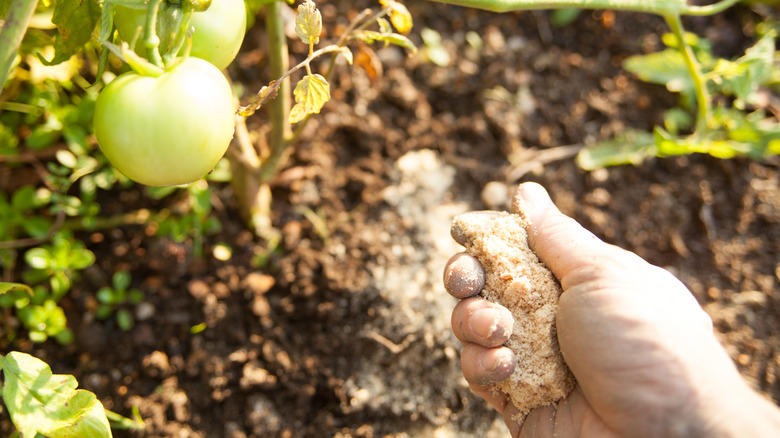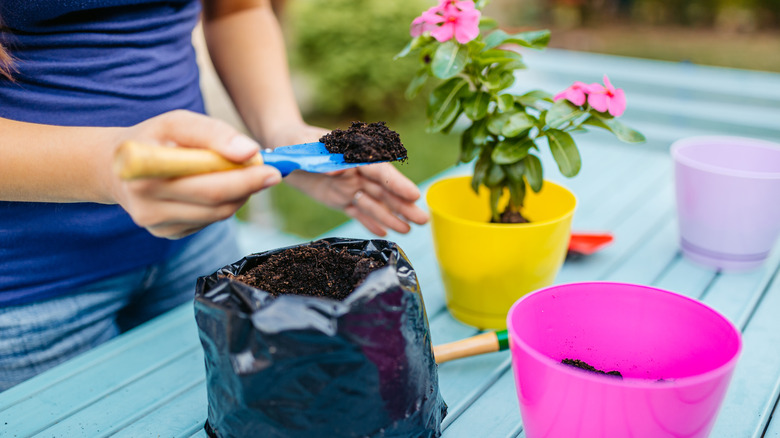The Tomato Feed Hack People Use On Potted Flowers (& Should You Try It?)
Even if you don't have much yard space to plant flowers directly in the ground, you can still add a beautiful pop of color to your space by decorating your patio with potted flowers. But that only works if your flowering plant of choice is healthy and happy enough to produce lots of blooms throughout its growing season. That's where the tomato feed hack comes in. Tomato feed is a fertilizer that adds the essential nutrients plants need to the soil. Usually, it's a potassium-rich formula, which is thought to be the best fertilizer for healthy tomatoes. Since it's intended to help tomato plants produce tons of fruit, some gardeners also use it to encourage potted flowers to produce tons of blooms.
While it's unlikely that the potassium is directly stimulating flower or fruit production, the tomato feed hack could still be worth a try. What does that mean for your potted flower plant? In short, it means tomato feed may help encourage it to put out more blooms — but only if you choose a well-rounded fertilizer, apply it correctly, and make sure you're taking care of all of its other needs, too. That includes regular watering and placing it where it will get plenty of light, even if that means moving your houseplants outdoors.
The role potassium plays
If you read the label on any tomato feed package, you typically see high levels of potassium, because the goal is to stimulate as much fruit production as possible. It's a widely held belief among gardeners that if you want more flowers or fruit, you should add more potassium to the soil. But, the scientific data available suggests that there's more to it than that. Flowering is a complex reproductive process that's triggered by a mix of hormones, genetics, and environmental factors. A plant's diet is just one of many factors that influence how many flowers it will produce.
With that said, potassium is an essential nutrient that, among other things, helps maintain water and nutrient levels inside plant cells. A healthy, nourished plant is going to be better able to produce flowers than a dehydrated or malnourished one. In that sense, you could say potassium is indirectly involved in flower production, but so are the other essential nutrients that make up a balanced plant diet.
How to use tomato feed for potted flowers
It may not be the magic flower-producer that some gardeners make it out to be, but a quality tomato feed is still a great fertilizer for your potted flowers. The trick is making sure you actually choose a quality tomato feed. Above all, make sure it's an organic-based fertilizer made from ingredients like bone meal, manure, fish, or composted plant matter. Since they're derived from organic ingredients, organic-based fertilizers usually have a more complete nutrition profile than synthetic fertilizers. It's sort of like the difference between eating whole grain bread and white bread.
Now, it's time to add it to your potted flowers. The package should include directions on how to apply it. In general, you'll start about two to six weeks after planting and add more tomato feed every two to three weeks after that. The key is to apply often enough to keep your plants nourished while avoiding over-fertilizing, which can burn the roots and disrupt the pH balance of the soil. That's another reason to go with organic-based products. They're less likely to cause root burn or upset the pH balance.
Finally, make sure your potted flowers are getting the recommended amount of light and water. With nutritious soil, plenty of water, and lots of light, your potted flowers should have everything they need to put on a stunning display of blooms.



